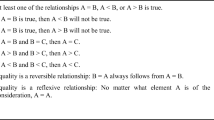Abstract
Symbols occupy a pivotal position between processes to be carried out and concepts to be thought about. They allow us both to do mathematical problems and to think about mathematical relationships. In this article we consider the discontinuities that occur in the learning path taken by different students, leading to a divergence between conceptual and procedural thinking. Evidence will be given from several different contexts in the development of symbols through arithmetic, algebra, and calculus, then on to the formalism of axiomatic mathematics. This evidence is taken from a number of research studies recently conducted for doctoral dissertations at the University of Warwick by students from the United States, Malaysia, Cyprus, and Brazil, with data collected in the United States, Malaysia, and the United Kingdom. All the studies form part of a broad investigation into why some students succeed, while others fail.
Résumé
Les symboles jouent un rôle central entre les processus à accomplir et les concepts auxquels on doit penser. Ils nous permettent à la fois de résoudre des problèmes mathématiques et de réfléchir aux relations mathématiques. Dans cet article, nous examinons les discontinuités qui apparaissent le long du chemin d’apprentissage emprunté par différents élèves et qui entraînent une divergence entre la pensée conceptuelle et la pensée procédurale. Nous fournirons des exemples tirés de plusieurs contextes différents illustrant l’acquisition des symboles par l’intermédiaire de l’arithmétique, de l’algèbre et du calcul différentiel et intégral, pour ensuite passer au formalisme des mathématiques axiomatiques. Ces exemples proviennent d’un certain nombre d’études menées récemment à l’Université de Warwick par des doctorants américains, malaisiens, chypriotes et brésiliens, et qui portent sur des données recueillies aux États‐Unis, en Malaisie et au Royaume‐Uni. Toutes ces études s’inscrivent dans le cadre d’une vaste recherche visant à déterminer les raisons pour lesquelles certains élèves réussissent alors que d’autres échouent.
Similar content being viewed by others
References
Ali, M.B. (1996). Symbolic manipulation related to certain aspects such as interpretations of graphs. Unpublished doctoral dissertation, University of Warwick, Coventry, UK.
Ali, M.B., & Tall, D.O. (1996). Procedural and conceptual aspects of standard algorithms in calculus. Proceedings of PME [Psychology of Mathematics Education] 20, Valencia, 2, pp. 19–26.
Anderson, C. (1997). Persistent errors in indices: A cognitive perspective. Unpublished doctoral dissertation, University of New England, Armidale, Australia.
Comu, B. (1991). Limits. In D.O. Tall (Ed.), Advanced mathematical thinking (pp. 153–166). Dordrecht, Netherlands: Kluwer.
Cottrill, J., Dubinsky, E., Nichols, D., Schwingendorf, K., Thomas, K., & Vidakovic, D. (1996). Understanding the limit concept: Beginning with a co-ordinated process schema. Journal of Mathematical Behavior, 15, 167–192.
Crowley, L., & Tall, D.O. (1999). The roles of cognitive units, connections and procedures in achieving goals in college algebra. In O. Zaslavsky (Ed.), Proceedings of the 23rd Conference of PME, Haifa, Israel. 2, pp. 225–232.
DeMarois, P. (1998). Aspects and layers of the function concept. Unpublished doctoral dissertation, University of Warwick, Coventry, UK
DeMarois, P., & Tall, D.O. (1999) Function: Organizing principle or cognitive root?. In O. Zaslavsky (Ed.), Proceedings of the 23rd Conference of PME, Haifa, Israel. 2, pp. 257–264.
Dubinsky, E. (1991). Reflective abstraction in advanced mathematical thinking. In D.O. Tall (Ed.), Advanced mathematical thinking (pp. 95–123). Dordrecht, Netherlands: Kluwer.
Dubinsky, E., Elterman, F., & Gong, C. (1988). The student’s construction of quantification. For the Learning of Mathematics, 8, 44–51.
Gray, E.M., & Tall, D.O. (1994). Duality, ambiguity and flexibility: A proceptual view of simple arithmetic. Journal of Research in Mathematics Education, 26(2), 115–141.
Gray, E.M., & Tall, D.O. (1991). Duality, ambiguity and flexibility in successful mathematical thinking. Proceedings of PME XIII, Assisi, 2, pp. 72–79.
Hiebert, J., & Lefevre, P. (1986). Procedural and conceptual knowledge. In J. Hiebert (Ed.), Conceptual and procedural knowledge: The case of mathematics (pp. 1–27). Hillsdale, NJ: Erlbaum.
McGowen, M. (1998). Cognitive units, concept images and cognitive collages. Unpublished doctoral dissertation, University of Warwick, Coventry, UK.
McGowen, M., & Tall, D.O. (1999). Concept maps and schematic diagrams as devices for documenting the growth of mathematical knowledge. In O. edZaslavsky (.). Proceedings of the 23rd Conference of PME, Haifa, Israel. 3, pp. 281–288.
Pinto, M.M., & Tall, D.O. (1999). Student constructions of formal theory: Giving and extracting meaning. O. Zaslavsky (Ed.), Proceedings of the 23rd Conference of PME, Haifa, Israel. 4, pp. 65–73.
Pitta, D. (1998). In the mind: Internal representations and elementary arithmetic. Unpublished doctoral dissertation, Mathematics Education Research Centre, University of Warwick, Coventry, UK.
Pitta, D., & Gray, E. (1997). In the mind: What can imagery tell us about success and failure in arithmetic?. G.A. Makrides(Ed.), Proceedings of the First Mediterranean Conference on Mathematics, Nicosia, Cyprus, 29–41.
Sfard, A. (1991). On the dual nature of mathematical conceptions: Reflections on processes and objects as different sides of the same coin. Educational Studies in Mathematics, 22, 1–36.
Tall, D.O. (1995). Mathematical growth in elementary and advanced mathematical thinking. Proceedings of the Nineteenth International Conference for the Psychology of Mathematics Education, Recife, Brazil, 1, 61–75.
Tall, D.O., & Thomas, M.O. (1991). Encouraging versatile thinking in algebra using the computer. Educational Studies in Mathematics, 22, 125–147.
Van Hiele, P. (1986). Structure and insight. Orlando, FL: Academic Press.
Yusof, Y. (1995). Thinking mathematically: A framework for developing positive attitudes amongst undergraduates. Unpublished doctoral dissertation, University of Warwick, Coventry, UK.
Yusof, Y., & Tall, D.O. (1996). Conceptual and procedural approaches to problem solving. Proceedings of PME 20, Valencia, 4, 3–10.
Yusof, Y., & Tall, D.O. (1999). Changing attitudes to university mathematics through problem-solving. Educational Studies in Mathematics, 37, 67–82.
Author information
Authors and Affiliations
Rights and permissions
About this article
Cite this article
Tall, D., Gray, E., Ali, M.B. et al. Symbols and the Bifurcation Between Procedural and Conceptual Thinking. Can J Sci Math Techn 1, 81–104 (2001). https://doi.org/10.1080/14926150109556452
Published:
Issue Date:
DOI: https://doi.org/10.1080/14926150109556452




